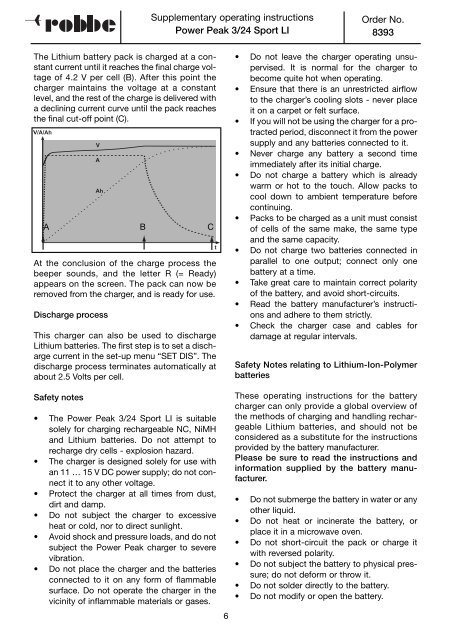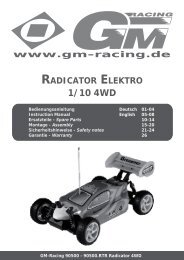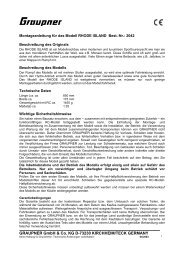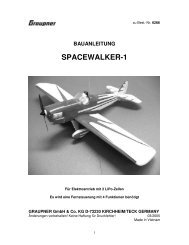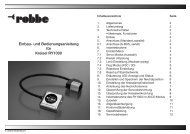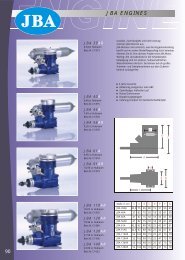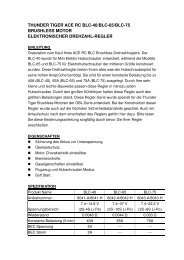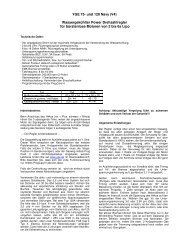Create successful ePaper yourself
Turn your PDF publications into a flip-book with our unique Google optimized e-Paper software.
Supplementary operating instructions<br />
Power Peak 3/24 Sport LI<br />
Order No.<br />
8393<br />
The Lithium battery pack is charged at a constant<br />
current until it reaches the final charge voltage<br />
of 4.2 V per cell (B). After this point the<br />
charger maintains the voltage at a constant<br />
level, and the rest of the charge is delivered with<br />
a declining current curve until the pack reaches<br />
the final cut-off point (C).<br />
A<br />
At the conclusion of the charge process the<br />
beeper sounds, and the letter R (= Ready)<br />
appears on the screen. The pack can now be<br />
removed from the charger, and is ready for use.<br />
Discharge process<br />
This charger can also be used to discharge<br />
Lithium batteries. The first step is to set a discharge<br />
current in the set-up menu “SET DIS”. The<br />
discharge process terminates automatically at<br />
about 2.5 Volts per cell.<br />
Safety notes<br />
• The Power Peak 3/24 Sport LI is suitable<br />
solely for charging rechargeable NC, NiMH<br />
and Lithium batteries. Do not attempt to<br />
recharge dry cells - explosion hazard.<br />
• The charger is designed solely for use with<br />
an 11 … 15 V DC power supply; do not connect<br />
it to any other voltage.<br />
• Protect the charger at all times from dust,<br />
dirt and damp.<br />
• Do not subject the charger to excessive<br />
heat or cold, nor to direct sunlight.<br />
• Avoid shock and pressure loads, and do not<br />
subject the Power Peak charger to severe<br />
vibration.<br />
• Do not place the charger and the batteries<br />
connected to it on any form of flammable<br />
surface. Do not operate the charger in the<br />
vicinity of inflammable materials or gases.<br />
B<br />
C<br />
6<br />
• Do not leave the charger operating unsupervised.<br />
It is normal for the charger to<br />
become quite hot when operating.<br />
• Ensure that there is an unrestricted airflow<br />
to the charger’s cooling slots - never place<br />
it on a carpet or felt surface.<br />
• If you will not be using the charger for a protracted<br />
period, disconnect it from the power<br />
supply and any batteries connected to it.<br />
• Never charge any battery a second time<br />
immediately after its initial charge.<br />
• Do not charge a battery which is already<br />
warm or hot to the touch. Allow packs to<br />
cool down to ambient temperature before<br />
continuing.<br />
• Packs to be charged as a unit must consist<br />
of cells of the same make, the same type<br />
and the same capacity.<br />
• Do not charge two batteries connected in<br />
parallel to one output; connect only one<br />
battery at a time.<br />
• Take great care to maintain correct polarity<br />
of the battery, and avoid short-circuits.<br />
• Read the battery manufacturer’s instructions<br />
and adhere to them strictly.<br />
• Check the charger case and cables for<br />
damage at regular intervals.<br />
Safety Notes relating to Lithium-Ion-Polymer<br />
batteries<br />
These operating instructions for the battery<br />
charger can only provide a global overview of<br />
the methods of charging and handling rechargeable<br />
Lithium batteries, and should not be<br />
considered as a substitute for the instructions<br />
provided by the battery manufacturer.<br />
Please be sure to read the instructions and<br />
information supplied by the battery manufacturer.<br />
• Do not submerge the battery in water or any<br />
other liquid.<br />
• Do not heat or incinerate the battery, or<br />
place it in a microwave oven.<br />
• Do not short-circuit the pack or charge it<br />
with reversed polarity.<br />
• Do not subject the battery to physical pressure;<br />
do not deform or throw it.<br />
• Do not solder directly to the battery.<br />
• Do not modify or open the battery.


